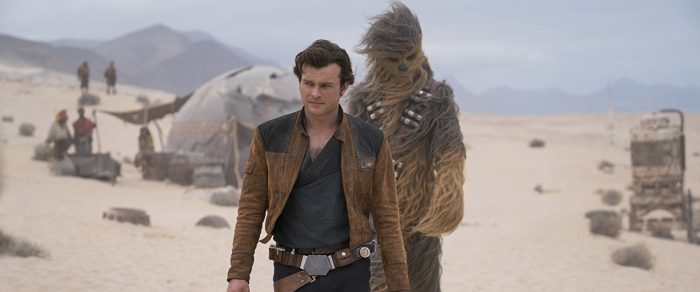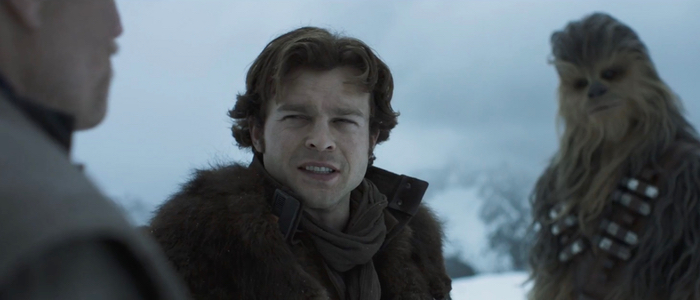Lawrence and Jonathan Kasdan on Writing Han Solo’s Origin and Figuring Out the Kessel Run [Interview]
A couple weeks ago, I sat down with screenwriters Lawrence Kasdan and Jonathan Kasdan to talk about Solo: A Star Wars Story. I learned how this movie started as a germ of an idea from George Lucas and we talked about how some of the deeper cut references and easter eggs were developed, their approach to these characters, and how they came to design the infamous Kessel Run.
The interview is mostly spoiler-free, so feel free to dig in.
***
Peter: Hello.
Jonathan: Slashfilm? Really nice to finally meet you!
Peter: I was a big fan of your film [The First Time].
Jonathan: Yeah, you’ve been great. Just terrific. Yes, thank you so much for that. With movies like that, it’s support like you gave that’s so meaningful. It’s such a big deal for a movie like that to get something nice and enthusiastic that can be shared around online. I’m very, very grateful.
Peter: It was a great film. I wish more people…maybe more people after this will see it.
Jonathan: Yeah. It does have one of those things, because Dylan just emerged as such a star that it has a life on iTunes and Netflix and I’m very kind of at peace with how it ended up sort of slipping into the world a little bit.
Peter: Yeah, it’s great. But we should probably get started and talk about Solo We’ve heard that the idea for this film came from George Lucas himself.
Lawrence: Eh… Not exactly.
Jonathan: Tell us.
Lawrence: In 2012, Kathy [Kennedy] asked me to come up and meet with her and George. Because they were gonna reboot, there were gonna be more Star Wars movies. This is before Disney bought the franchise. And when I got there, they said, here we have nine ideas. And those were George’s ideas. And I said, well I’m not sure I wanna do this. I’ve really done a lot of Star Wars. And they said, but look, one of these is Han Solo. I said, well okay. I do love Han Solo. And…
Peter: Did it just say Han Solo or did he have an idea for it?
Lawrence: Yeah, it was a page sort of a very brief outline of where it could go. And I didn’t say that’s what I wanted to do. I said, the idea of doing a movie about Han is interesting to me. And three weeks later, Disney bought the whole thing. And George was really emeritus. And those, I don’t think those pages ever showed up again.
Jonathan: He had so much material that he developed over the years, there really is like a treasure trove of stuff that you can go back and one thing that we did have and we had in the room with us was a folder that contained an interview I think he’d done in 1980 or something with someone who worked in the organization where they just like asked him about Han’s past for like an hour. And you can see him just like making shit up as he went. And it’s got things in there that are great.
Peter: Was that like that famous Indiana Jones meeting… [Peter just realizes that Lawrence was part of that conversation] Were you part of that?
Jonathan: Yes. That is the story group, yeah. But this was just him talking, expounding. It’s not as good as this, that meeting. But it was a lot of him just talking about what he thought it could be and he did that with everybody, his imagination was sort of boundless.
Peter: You mentioned these ideas that he’s planted over the years and it seems like there’s a lot of Easter Eggs and deep cuts in this film. How did they make it [the movie[, even stuff from the PlayStation Games and…?
Jonathan: Yeah, absolutely. Well, that particular thing you’re referring to, it’s like a perfect example.
Lawrence: What is it?
Jonathan: Like Teras Kasi.
Lawrence: Uh huh.
Jonathan: Which is something that you’ve got to, you’re writing these movies and somebody’s saying, well, she’s gotta be able to have some skills. And you say like okay, well she’s gotta have some skills. What are they gonna be and how can they be different than Rey or this Felicity character? And we said like and you start to dig into Wookieepedia and you start to say, well what are different kinds of martial arts within the games? (Spoiler invisotext, highlight to reveal) And then we say, well we did wanna land this nugget about Darth Maul and maybe if the fighting style is connected to Maul in some way, that’d be really cool. (end invisotext) And so you start to sort of fill in the gaps with the canon. And with these deeper cuts and like I was saying, I was in love with this idea of Lando writing his autobiography. And I thought–
Peter: The Lando Chronicles.
Jonathan: Yeah, The Lando Chronicles. So, each one of them is sort of a… There’s that one in the movie and then there’s a few others that are references to early novels and the books and that were written right at the beginning, I think in ’79. The Mindharp of Sharu is a big part of how this Empire began. So it’s fun to be able to pick and choose sort of what you wanna keep and what you don’t.
Peter: One of the things I love about this film is that, in A New Hope, Han Solo was a bad guy with the core of being a good guy. And this is like the opposite, it’s a good guy wanting to be the bad guy. Can you talk a little bit about that?
Lawrence: That’s a good analysis.
Jonathan: It’s a beautiful, eloquent way to put it.
Lawrence: And part of the attraction to the character is that he is the guy that says, I don’t stick my neck out for anybody. He always wants to put on a front of being the tougher guy, the more cynical guy. But he in this movie, you’re seeing him just try to build that persona for himself. And there’s a witness there from his childhood who says, no, you’re the good guy. She knows what his heart is like. And turns out that she’s maybe a tougher character than he is. And maybe her mind encompasses his. So it’s all about the fact that none of us are any one simple thing.
Jonathan: But that idea that and one of the things I think that why my dad responded so strongly to Han as a character when he saw A New Hope is he recognized an archetype of a Bogart-type character that really has a through line to [Treasure of the Sierra Madre] and to a lot of Westerns and stuff like that where it’s the guy who says, absolutely I will never help anyone ever and you know in the end he’s gonna do it begrudgingly. In Casablanca, I mean, Rick is the ultimate guy like that. And it’s not subtle what George is doing with Mos Eisley and Casablanca. I think if that movie came out today, people would say, oh he just ripped off Casablanca. But he did it so artfully and it fits so nicely at that time that that mold of a character was a great form to work in. And to then be able to go backwards and say, how do you get to be Rick? And how do you get to be Bogart or McQueen? It was a fun challenge and writing experiment.
Peter: I was afraid this film was gonna be a list of things like here’s how he met Chewie and so on, and it was that, but it was always done in an unexpected way.
Jonathan: Right.
Lawrence: That’s what I like to hear.
Jonathan: That’s the dream.
Peter: And the Kessel Run I feel like is something we fans have been imagining for decades now. How did you tackle that? How did you come up with the idea of how it was gonna work?
Jonathan: That was the big issue, because it’s one of those things that he says and it’s so, such a cool toss-away line because it’s one of those lines where he’s saying three things at once and you don’t like understand any of them. It’s like don’t you understand, Millennium Falcon? It’s the ship that made the Kessel Run in 12 parsecs. And you’re like what, wait, what? That just sounds cool. But then when you get into the dissecting the words of that sentence and you realize that a parsec is not a unit of time, it’s a unit of distance, you’re immediately faced with all these problems and we very quickly in the first draft arrived at the conclusion that we would equate it to the idea of somebody flying into a hurricane. Of a, or rather of a ship’s captain piloting a ship into a hurricane. And that kind of pirate idea of someone who’s like the only way out is to travel right through that hurricane. And we thought that made sense for Han as a character. He would be the guy who would do that. And if we did that, we could throw anything in the world at him that we wanted.
***
Solo: A Star Wars Story is in theaters now.
The post Lawrence and Jonathan Kasdan on Writing Han Solo’s Origin and Figuring Out the Kessel Run [Interview] appeared first on /Film.
from /Film https://ift.tt/2koVDzd





No comments: